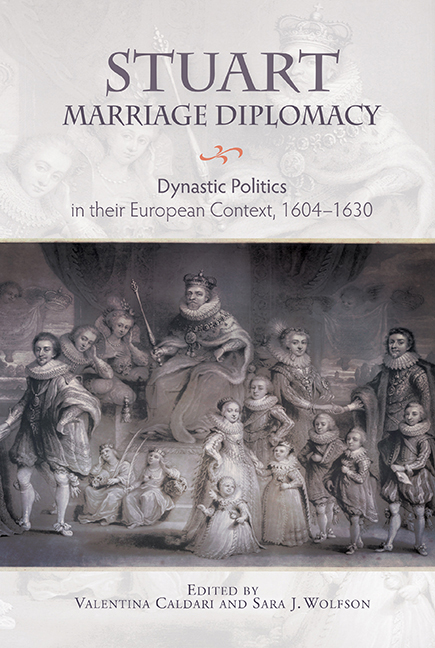Book contents
- Frontmatter
- Contents
- List of Illustrations
- List of Contributors
- Acknowledgements
- List of Abbreviations
- Introduction
- Part One Marriage and the Court
- 1 The French Match and Court Politics
- 2 What Can Be Fuller of Wonder? Buckingham and the Revenge of the Hispanophiles in 1626
- 3 Practical Proselytizing: The Impact of Counter-Reformation Catholicism at the Caroline Court, 1625–26
- Part Two Marriage and Politics
- Part Three Marriage and War
- Part Four Marriage and News
- Part Five Marriage and Continental Europe
- Part Six Marriage and Ceremony
- Bibliography
- Index
- Studies in Early Modern Cultural, Political and Social History
3 - Practical Proselytizing: The Impact of Counter-Reformation Catholicism at the Caroline Court, 1625–26
from Part One - Marriage and the Court
Published online by Cambridge University Press: 24 October 2019
- Frontmatter
- Contents
- List of Illustrations
- List of Contributors
- Acknowledgements
- List of Abbreviations
- Introduction
- Part One Marriage and the Court
- 1 The French Match and Court Politics
- 2 What Can Be Fuller of Wonder? Buckingham and the Revenge of the Hispanophiles in 1626
- 3 Practical Proselytizing: The Impact of Counter-Reformation Catholicism at the Caroline Court, 1625–26
- Part Two Marriage and Politics
- Part Three Marriage and War
- Part Four Marriage and News
- Part Five Marriage and Continental Europe
- Part Six Marriage and Ceremony
- Bibliography
- Index
- Studies in Early Modern Cultural, Political and Social History
Summary
Traditional accounts of Henrietta Maria's original French Catholic household have argued that domestic and religious tensions at the Caroline court were the principal factors behind Charles I's expulsion of the majority of his wife's officers in July 1626. In defending his actions to his brother-in-law, Louis XIII, Charles accused Henrietta Maria's French ecclesiastical household of working against his government by creating a Catholic faction in his kingdom. On a more personal level, the king resented the French household's introduction of what he perceived as intrusive Catholic devotional practices that restricted physical access to his wife. As Charles stated,
But the most greiuous of all is, that they trouble the peace betweene us and our deare Espouse by introducing new opinions contrary to the Lawes and rights of Marriage and the due obedience and affecconate accommodation due in the Civill rights thereof. And the more to confirme theire power to doe soe, they wrought upon her sweete and zealous heart by subiecting her to certaine new orders and Inventions neuer heard of in the Cannonicall doctrine of the Church of Rome or other Roamine Catholique Church, and by making her tender and fearefull by such nouelties, they hardned her against the iust and ordinary duties and affecion of Marriage bonds.
This official story was echoed more widely in Protestant contemporary discourse. According to John Pory, a London newswriter, Henrietta Maria's ecclesiastical officers ‘by way of confession’, would discover ‘how often in a night the king had kissed her’. Tensions at court were heightened further by the colourful depiction of the queen allegedly walking barefoot from St James's to the gallows at Tyburn's Triple Tree to honour Catholic martyrs. Although Protestants initially hoped that Henrietta Maria would convert to the Anglican faith, her overt Catholic devotions soon dampened these speculations.
At first glance, these displays of Counter-Reformation practices and Protestant responses to them indicate the struggle for confessional hegemony that existed within the Caroline court in 1625–26. Unease at the French household's pilgrimage to St James's, coupled with the disruption to Protestant services by the queen and her French officers at Titchfield in September 1625, resonates with Dagmar Freist's study of mixed marriages in eighteenth-century Germany.
- Type
- Chapter
- Information
- Stuart Marriage DiplomacyDynastic Politics in their European Context, 1604–1630, pp. 43 - 64Publisher: Boydell & BrewerPrint publication year: 2018

